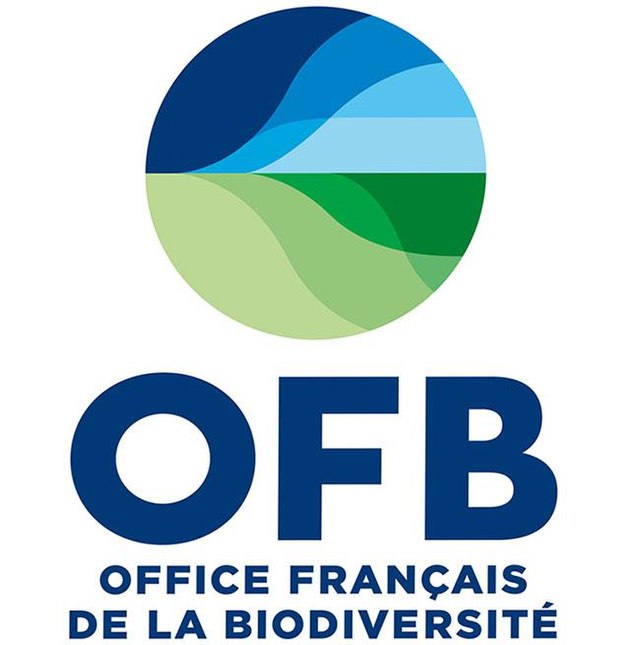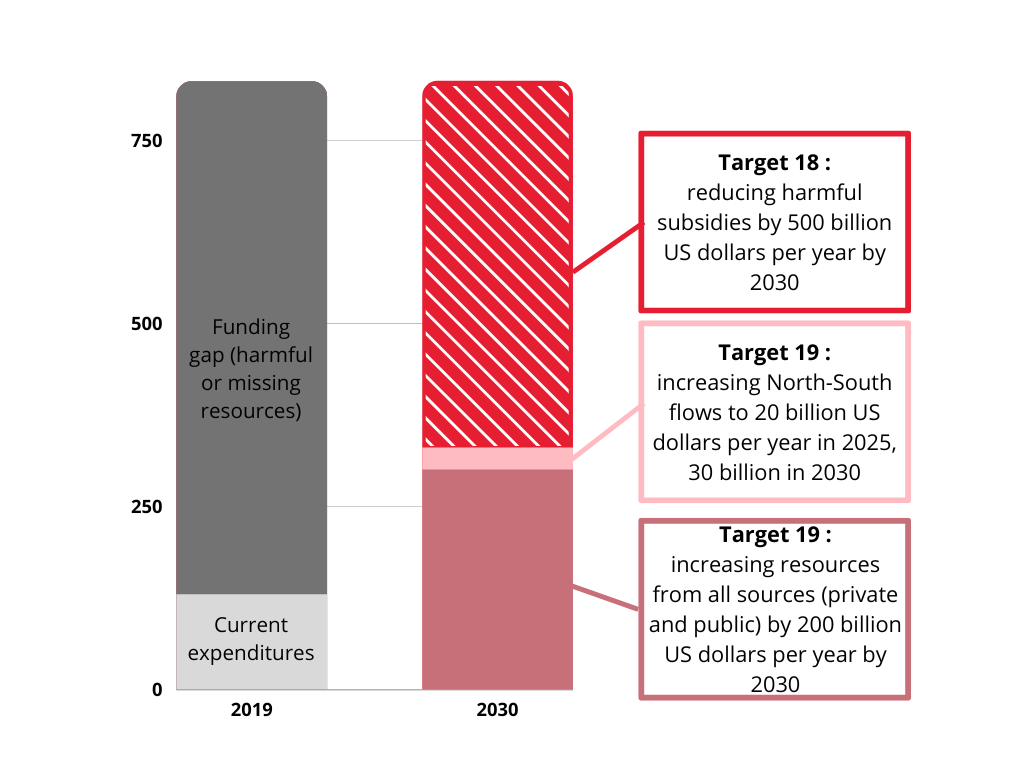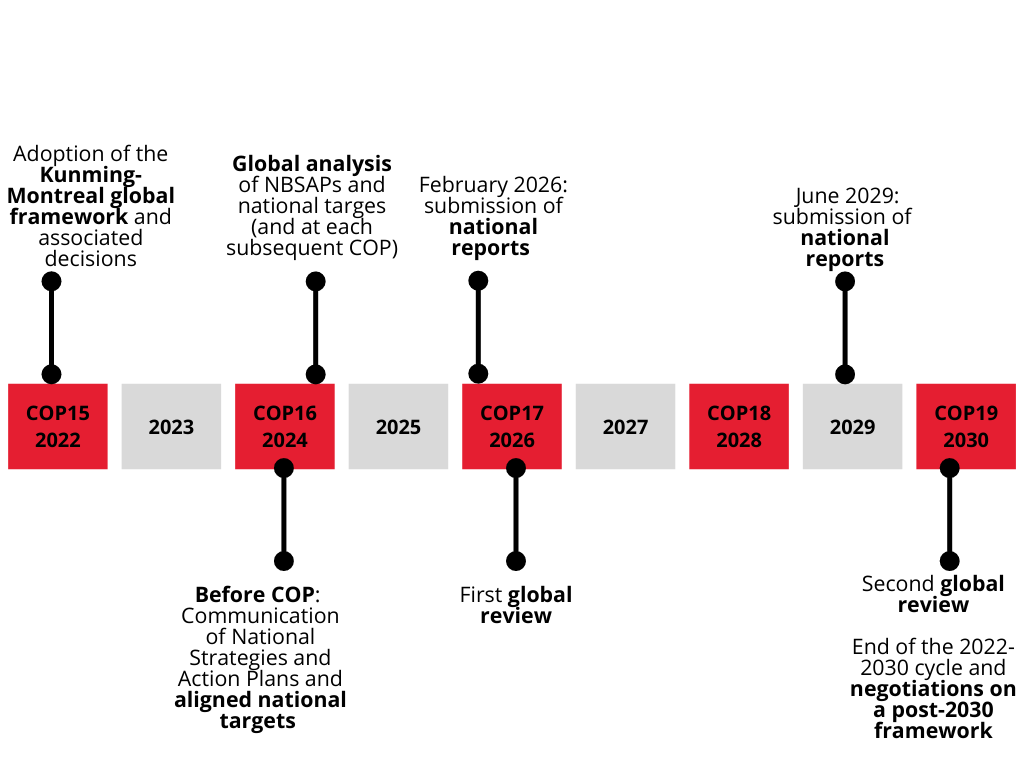
After four years of negotiations, largely disrupted by the Covid-19 pandemic, and two weeks of a 15th Conference of the Parties to the Convention on Biological Diversity that sealed the final content, the post-2020 Global Biodiversity Framework (GBF) was adopted in Montreal on December 19, 2022. The objective is to halt and reverse the loss of biodiversity that the Aichi targets set for the previous ten-year period (2011-2020) had failed to contain. Despite weaknesses and shortcomings, the agreement is a major step forward compared to what existed at the UN level on biodiversity protection. IDDRI, which has been present throughout the negotiation period, unpacks and examines in this blog post the main achievements and challenges to implement the transformations necessary under the new agreement.
An "historic agreement" was the term most often heard in the corridors of the Montreal Convention Centre after the agreement was adopted in the early hours of December 19. It is also the language used by many delegations in their official communications and press releases. The word is strong and reflects a form of relief on the part of those involved in the negotiations, after four years of painful negotiations and the fear of a "Copenhagen of biodiversity". At the cost of intense diplomatic work between Northern countries, major emerging countries and developing countries, the Chinese presidency, which had been shadowy until then, facilitated, with the support of the host country (Canada), the adoption of an agreement with undeniably significant progress on at least three levels: (i) quantified objectives and targets on important commitments; (ii) mobilization of financial resources to ensure their implementation; and (iii) a process and indicators for regular monitoring of commitments, imposing transparency and accountability.
Quantified objectives and targets
This was the objective of many countries: to reach commitments whose ambition is translated into quantified and measurable objectives. The Kunming-Montreal agreement meets this requirement in several respects.
This is particularly true of Goal A for 2050, which aims to reduce the rate and risk of extinction of all species by a factor of 10. This is also the case for several targets to be implemented by 2030: Target 2 provides for the "effective restoration" of at least 30% of degraded terrestrial, inland water, coastal and marine ecosystems; Target 3, a flagship provision particularly defended by NGOs, establishes the "30x30 target", i.e. the establishment by 2030 of networks of protected areas covering 30% of land and 30% of sea. Some will regret the lack of reference to strict protection and the mention of "sustainable use" which is open to interpretation. However, and more generally, this 30x30 target, supported by the High Ambition Coalition for Nature and People, was not a given at the outset and can undoubtedly be considered an ambitious conservation target, in line with the demands of most environmental organizations.
The IPBES had also emphasized the importance of structural changes in the technical systems that exert pressure on biodiversity, without which the protection of spaces and species would be in vain: the results of the negotiations on Target 7 dedicated to pollution were therefore particularly expected, in particular on the issue of pesticides, for which the European Union was keen to make a strong commitment. The compromise resulted in an objective of halving, not the quantity of pesticides used, but the "overall risk from pesticides and highly hazardous chemicals". From a scientific point of view, the reference to risk is relevant, as some pesticides are more harmful than others: as an example, between 1992 and 2016, the United States reduced the quantity of certain pesticides by 40% while increasing the risk by a factor of 41 . Whatever the definition used, the goal of halving the risk by 2030, and going even further after that date, should have profoundly transformative effects, as it seems difficult to achieve it without a fundamental rethinking of crop health protection (e.g., through the re-complexification of rotations, the re-diversification of large specialized regions, or the use of chemistry only as a last resort).
Mobilizing financial resources
This was naturally one of the thorny issues of the negotiations, on which countries had not been able to agree during the technical discussions and for which arbitration at the ministerial level was expected. Broadly speaking, the positions before Montreal were as follows. On the one hand, the Northern countries, subjecting their financial contribution to the adoption of ambitious objectives, wishing for a measured increase in their financial flows to the South (the first draft of the treaty mentioned $10 billion per year), favouring the use of the Global Environment Facility (GEF) as a financial mechanism, and emphasizing the mobilization of funding from "all sources". On the other hand, the countries of the South demanded a substantial financial transfer (the figure of $100 billion dollars per year has long been mentioned by several countries) and the creation of an independent ad hoc fund for biodiversity.
The compromise reached is based on an increase in financial resources dedicated to biodiversity, from all sources, to $200 billion per year by 2030, including a financial contribution from developed countries2 of 20 billion per year by 2025 and 30 billion per year by 2030. With regard to the financial mechanism and thanks to a compromise facilitated by Colombia, a trust fund will be created to support the implementation of the global framework for biodiversity, but under the aegis of the GEF, until 2030 unless the Conference of the Parties decides otherwise4 . At the same time, the agreement provides for the exploration of the possibility of creating a specific fund outside the GEF5 .
As a necessary corollary to increasing resources for biodiversity, the elimination, phasing-out or reform of harmful subsidies, estimated at $1.8 trillion annually, is specifically targeted for reduction by at least $500 billion per year by 2030.

A regular monitoring process
The failure of the 2011-2020 Aichi Targets was explained by the lack of a regular monitoring and review of the contributions. The international community has learned from this and the Kunming-Montreal agreement6 includes several obligations in this regard, both individual and collective. Each country will have to revise its National Biodiversity Strategy and Action Plan (NBSAP) by COP16 (to be held in 2024 in Turkey) and submit national targets aligned with the new global targets. All of these national targets will be subject to a "global analysis" to assess their aggregate contribution to the collective ambition at COP16 and at each COP. Once the targets have been planned, countries will be required to submit a national report on implementation on two occasions until the end of the cycle (in February 2026 and June 2029) that will form the basis of a "global review" at COP17 (2026) and COP19 (2030). The modalities of this mid-term and end-of-cycle "review" have yet to be determined, including the different sources of information that will be taken into account (and in particular the use of independent expertise rather than simple self-declaration by States) and the associated procedures.
These monitoring mechanisms strengthen both the monitoring of targets, notably by relying on more harmonized and comparable7 indicators8 and reporting formats, and the monitoring of the means of implementation. Countries are further encouraged to prepare national finance plans associated with their national strategy and targets9 and will be able to indicate their needs for their national targets to be communicated by COP16, if they deem it necessary.

An agreement that can be improved
Of course, the agreement is not perfect. The provisions on agriculture, for example, are the result of a compromise between countries with such different approaches and practices that Target 10 mixes the notions of sustainable intensification and agroecology, questioning its scope as it does not propose a new trajectory for the sector. These formulations remain at the scale of practices, and not of more systemic changes, they do not explicitly highlight the need for structural changes in relation to the heavy trends in place in many territories (simplification of rotations and standardization of agricultural landscapes, specialization of production basins, for example) which the IPBES indicates are one of the main factors of biodiversity degradation.
In the same way, we can regret certain precautions of language used in Target 15 devoted to the evaluation and disclosure by large companies and international financial institutions of their risks, dependencies and impacts on biodiversity-even if its content remains in line with the work of the "Taskforce on Nature-related Financial Disclosures (TNFD)".
Furthermore, the consideration of the results of the global assessments to increase ambition is at the discretion of the Parties and the review of the reports remains voluntary, thus reducing the possibilities to demonstrate the effectiveness of individual national efforts.
Some will also regret the (classic) precautions in the language used-"where appropriate", "significantly increase", "as appropriate"-which reduce the scope of certain targets, and the absence of reference to the notion of ecological footprint and therefore the possibility of directly questioning the issues of sufficiency.
This global framework is nonetheless an ambitious compromise, not the "lowest common denominator" that was so feared, and a roadmap whose historic dimension, somewhat hastily proclaimed, must be translated into effective implementation as soon as possible.
"The beginning of a beginning”
For, as Basile van Havre, co-chair of the negotiating group, noted a few hours after the adoption of the agreement, "this is the beginning of a beginning. Time is short, as the international community has eight years to achieve the goals and targets set for 2030. The time for implementation must therefore begin now.
This requires States to prepare National Biodiversity Strategies and Action Plans aligned with the Kunming-Montreal Agreement and to develop national finance plans, which could highlight support needs and constitute one of the key levers for shifting national political trade-offs that have in the past been too often to the detriment of biodiversity. In addition to the funding already earmarked for rapid implementation of the new global framework, the GEF will need to approve the creation of a dedicated biodiversity fund and put in place the necessary institutional arrangements to allow it to be matched by various sources. More broadly, the resource mobilization strategy adopted in Montreal will have to be implemented, notably through the mobilization of multilateral development banks and financial institutions. Intergovernmental organizations will also have an essential role to play as they will have to implement the global framework in the various sectors concerned. We expect sectoral organizations, both global and regional, to define a work program dedicated to the implementation of the various goals and targets. Finally, civil society must continue to be mobilized for the next steps. If Montreal was recognized as a success, it is also because scientists and NGOs played their part in forcing the States to go back home with significant results. And the agreement adopted must now constitute a lever for civil society to force States to act and implement their commitments.
This blogpost was produced with the support of the Office français de la biodiversité (OFB).
- 1 Secretariat of the Convention on Biological Diversity. Science briefs on targets, goals and monitoring in support of the post-2020 global biodiversity framework negotiations. 2022. CBD/WG2020/4/INF/2/Rev.2.
- 2 Note in this Target 19 the mention of countries that voluntarily assume the obligations of developed countries, opening the way for a possible contribution from emerging countries.
- 4 Ibid, 30.
- 5 Ibid, 42.
- 6 And Decision CBD/COP/15/L.27, Mechanisms for planning, monitoring, reporting and review.
- 7 As an annex to decision CBD/COP/15/L.27.
- 8 The "monitoring framework" adopts several types of indicators, including flagship, component, and complementary indicators (CBD/COP/15/L.26).
- 9 CBD/COP/15/L.29.



